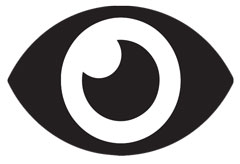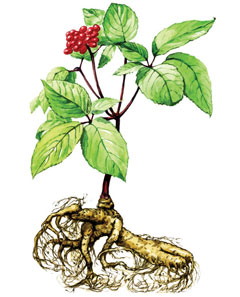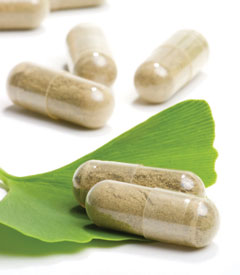 |
A 65-year-old black male presented with acute, painless redness of his left eye for one day. He denied any history of chronic medical conditions, although he admitted to not visiting his primary care provider (PCP) in a few years. He also denied previous episodes of ocular redness, trauma, Valsalva maneuver, contact lens wear or regular aspirin use. The patient reported using Tienchi (Panax notoginseng), an herbal remedy, for two weeks after reading claims that it prevents hypertension.
Clinical examination was remarkable for an acute subconjunctival hemorrhage in the left eye. Dilated fundus exam was unremarkable. Blood pressure in office measured 195/100mm Hg. A diagnosis of subconjunctival hemorrhage in the left eye was established, the likely cause of which was systemic hypertension with possible additive effects from the herbal supplement.
He was referred to his PCP for immediate re-evaluation and management of hypertension, as well as a complete physical exam and serology to rule out comorbidities such as diabetes and heart disease.
 |
| For centuries in Eastern medicine, herbal therapies have played a major role in the management of a host of conditions. |
We advised the patient to discontinue his use of Panax notoginseng due to its potential anticoagulant and antiplatelet properties, as well as risks of systemic complications. He was advised to consult with his PCP and us before embarking on additional high-dose vitamins, herbs and supplements. We indicated that a return to Panax notoginseng at a lower dose can be considered after resolution of the subconjunctival hemorrhage, as part of a physician-supervised blood pressure treatment program. Unfortunately, he was lost to follow up.
The Facts on Herbs
Botanists describe an herb as a small, seed-bearing plant with fleshy, rather than woody, parts (from which we get the term ‘herbaceous’). In addition to herbaceous perennials, herbs may include trees, shrubs, annuals, vines and more primitive plants such as ferns, mosses, algae, lichens and fungi.1,2 Herbs are valued for their flavor, fragrance, economic and industrial uses, pesticidal properties, coloring (dyes) and medicinal qualities. Herbal supplements in Western health care are increasing in popularity, as many are purported to augment one’s wellbeing. Typically categorized as complementary and alternative medicine (CAM), they represent a group of health practices and products not part of standard medical care.1 Research suggests about 38% of adults and 12% of children in the United States use some form of CAM.1Researchers estimate that more than 15 million Americans today take herbs, vitamins or both, along with their prescription medications.2 These numbers are expected to rise with easy access to unfiltered information from nutraceutical companies and the Internet.
Most herbal supplements are available over-the-counter (OTC) and easily found online, at local stores and in pharmacies. They come in all forms (dried, chopped, powdered, capsule or liquid) and can be used in a variety of ways, including:
- Swallowed as pills
- Brewed as tea
- Applied to the skin as gels
- Added to bath water
The FDA currently considers herbal supplements as food products, and as such they are not subject to the same clinical trials, manufacturing standards and regulations as drugs.1,2
Many prescription drugs and OTC medicines are also made from plant derivatives, but these products contain only purified ingredients and are regulated by the FDA.
What is Tienchi?
Panax notoginseng is prescribed in traditional Chinese medicine to improve circulation and resolve blood stasis.3 It is often used in an attempt to decrease blood pressure and slow the heart rate, as it exhibits antiplatelet and anticoagulant properties.3
 |
| Tienchi is typically taken as a liquid herbal extract or in a tablet form. Photo: ©iStock.com/JobsonHealthcare. |
Researchers demonstrated significant inhibition of platelet aggregation using both raw and steamed forms of Panax notoginseng.4 Results overall demonstrated samples that were steamed for two hours (3.3mg/ml) had similar partial thromboplastin time as heparin (0.033U/ml).4 An oral dose of 500mg/kg of steamed Panax notoginseng also had a similar percentage of platelet inhibition as 25mg/kg of aspirin.4
Adverse effects include bleeding complications, herb-drug interactions and vasodilation and vasoconstriction, depending on the dose and the targeted blood vessels.3,4Other Common Herbs
Patients are beginning to use several common herbal supplements more frequently for the prevention, treatment or both of ocular and systemic conditions:
• Allium sativum, or garlic supplement, is often taken for cardiovascular conditions or infectious disease prevention.5,6 It may reduce plaque formation, inhibit platelet aggregation, increase fibrinolysis and reduce blood pressure.5,6,7 Adverse effects associated with high doses include hypotension, herb-drug interactions, nausea and bleeding complications.5,6• Ginkgo biloba, also known as just ginkgo or the maidenhair tree, is among the most widely used herbs for conditions ranging from memory loss to poor blood circulation, and even glaucoma.7 The chemical components may have anti-inflammatory and neuroprotective properties and may improve blood flow.8
Information on Herbal SupplementsOffice of Dietary Supplements (ODS), National Institutes of Health (NIH)
National Center for Complementary and Integrative Health (NCCIH), NIH
National Registry of Drug-induced Ocular Side Effects
Natural Medicines Comprehensive Database
|
Ginkgo biloba was shown to increase the survival of retinal ganglion cells in experimental models of glaucoma in a dose-dependent manner.11 However, only limited data are available to support its clinical use in glaucoma prevention and treatment.7-10,12
• Cannabis sativa, or marijuana, is used for various conditions including muscle spasms, seizure disorder, Crohn’s disease, chronic pain, nausea and vomiting caused by chemotherapy and loss of appetite and weight in people with AIDS.1,2,5,7 It has also been used to lower IOP by reducing aqueous humor production.7,13 A recent study suggests some efficacy in IOP lowering, but the effects are short-term, and both oral and inhaled preparations were not tolerated for more than a few months due to significant adverse effects.
Adverse effects include short-term memory loss, drowsiness, euphoria and dependency.13
 |
| Although the precise mode of Ginkgo biloba’s action is not fully understood, it is a potent antioxidant and free-radical scavenger, nitric oxide inhibitor, vasodilator, platelet-activating factor inhibitor and glutamate NMDA receptor inhibitor. Photo: ©iStock.com/JobsonHealthcare. |
Research suggests bilberry has antioxidative and antiangiogenic properties that may help decrease blood vessel permeability in diabetic retinopathy and age-related macular degeneration.15,16
Adverse effects include bleeding, constipation and nausea.16,17
Tips for Clinicians
A 2006 survey evaluated whether herbal medicines interfere with the effects of anticoagulant and antiplatelet therapies.18 Among the 250 patients, 42.4% used herbal medicines, and 21% of those patients co-ingested herbal supplements with antiplatelet and anticoagulant therapy. About 50% of patients who co-ingested were at risk for potential drug-herb interaction. More than 90% did not reveal the use of herbal supplements to their health care providers, highlighting the need for proper history taking and communication, as well as a greater practitioner awareness.18 Because patients may not disclose the use of herbal supplements to their health care providers without specifically being asked, it is critical that optometrists include questions about vitamins, minerals and herbal supplements when conducting a pharmacologic history. Patients may ask your opinion on the efficacy and safety of herbal remedies and other types of CAM for ocular conditions, and you should not dismiss them; instead, look to the scientific evidence available and advise accordingly.
Fortunately, we are not alone. Clinical pharmacists, registered dietitians and certified nutritionists are frequently well versed on herbal remedies. Find one whose philosophies align with yours, keeping patient health and wellness as the paramount goal. If you recommend a particular vitamin, herb or supplement for your patients, send a courtesy letter to their PCPs describing the specific therapy, dosing and rationale for treatment.
Because herbal remedies and supplements are commonly prescribed by Eastern medicine, other health care providers and even patients themselves, knowing the most frequently used agents will permit better understanding of their benefits and possible adverse sequelae and aid in proper management.
Dr. Kim practices at LakeRidge Vision Source, a private practice located in Virginia, and is a fellow of the American Academy of Optometry.
|
1. Barnes PM, Bloom B, Nahin R. The Use of Complementary and Alternative Medicine in the United States. 2008. http://nccam.nih.gov/news/camstats/2007/camsurvey_fs1.htm. Accessed January 2, 2015. 2. Eisenberg DM, Davis RB, Ettner SL, et al. Trends in alternative medicine use in the United States, 1990-1997: results of a follow-up national survey. JAMA. 1998;280:1569-75. 3. Lei XL, Chiou GC. Cardiovascular pharmacology of Panax notoginseng (Burk) F.H. Chen and Salvia miltiorrhiza. Am J Chin Med. 1986;14(3-4):145-52. 4. Lau AJ, Toh DF, Chua TK, et al. Antiplatelet and anticoagulant effects of Panax notoginseng: comparison of raw and steamed Panax notoginseng with Panax ginseng and Panax quinquefolium. J Ethnopharmacol. 2009;125(3):380-6. 5. Anastasi JK, Chang M, Capili B. Herbal supplements: Talking with your patients. Journal for Nurse Practitioners. 2011;7(1):29-35. 6. Wong A, Townley SA. Herbal medicines and anesthesia. Cont Edu Anaesth Crit Care and Pain. 2011;11(1):14-17. 7. Schwartz S, Chavis P. Dietary supplements and the ophthalmologist. Compr Opthalmol Update. 2005;6(3):153-9. 8. DeFeudis FV, Drieu K. Ginkgo biloba extract (EGb 761) and CNS functions: basic studies and clinical applications. Curr Drug Targets. 2000;1(1):25-58. 9. Quaranta L, Bettelli S, Uva MG, et al. Effect of Ginkgo biloba extract on preexisting visual field damage in normal tension glaucoma. Ophthalmology. 2003;110:359-62. 10. Guo X, Kong X, Huang R, et al. Effect of Ginkgo biloba on visual field and contrast sensitivity in Chinese patients with normal tension glaucoma: a randomized, crossover clinical trial. Invest Ophthalmol Vis Sci. 2014;55:110-6. 11. Ma K, Xu L, Zhan H, et al. Dosage dependence of the effect of Ginkgo biloba on the rat retinal ganglion cell survival after optic nerve crush. Eye. 2009;23:1598.1604. 12. Schneider C, Bord C, Misse P, et al. Spontaneous hyphema caused by Ginkgo biloba extract. J Fr Opthalmol. 2002;25(7):731-2. 13. Flach AJ. Delta-9-tetrahydrocannabinol (THC) in the treatment of end-stage open-angle glaucoma. Trans Am Ophthalmol Soc. 2002;100:215-22. 14. Canter PH, Ernst E. Anthocyanosides of Vaccinium myrtillus (bilberry) for night vision-a systematic review of placebo-controlled trials. Surv Ophthalmol. 2004;49:38-50. 15. Roy S, Khanna S, Alessio HM, et al. Anti-angiogenic property of edible berries. Free Radic Res. 2002;36:9:1023-31. 16. Izzo AA, Ernst E. Interactions between herbal medicines and prescribed drugs: an updated systematic review. Drugs. 2009;69(13):1777-98. 17. Ulbricht C, Basch E, Basch S, et al. An evidence-based systemic review of bilberry (Vaccinium myrtillus) by the Natural Standard Research Collaboration. J Diet Suppl. 2009;6(2):162-200. 18. Saw JT, Bahari MB, Ang HH, Lim YH. Potential drug-herb interaction with antiplatelet/anticoagulant drugs. Complement Ther Clin Pract. 2006;12(4):236-41. |

